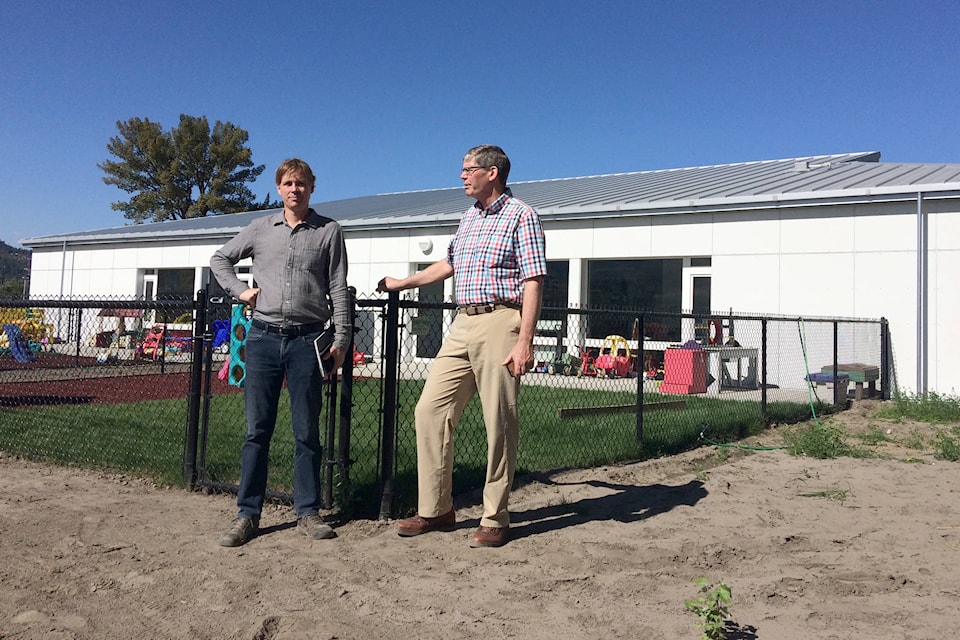Penticton is now home to one of the most energy efficient daycares in the country.
The Little Learners Academy, located on Okanagan College’s Penticton campus, is Canada’s first Passive House certified child care centre, earning the sought-after designation last month at the NetPositive Symposium hosted by Passive House Canada in Vancouver.
Related: Penticton company wins twice at building awards
The project is being recognized locally with news that it has been named a Silver Finalist for the 2018 Tommie Awards in the category of Best Environmental Initiative in Construction (Residential or Commercial).
The project was announced by the B.C. Ministry of Children and Family Development at a groundbreaking event in November 2016. Less than a year later, the centre is operating in full swing, complete with 37 children using the facility.
News that the child care centre received official certification from the Passive House Institute (Passivhaus Institut) in Darmstadt, Germany is welcome for the college, which has built a strong reputation as a leader in sustainable construction.
“Sustainability is one of Okanagan College’s core values, and building the first Passive House child care centre in Canada is a milestone to celebrate,” said Jim Hamilton, president of Okanagan College. “We are pleased to be part of creating an innovative space for the next generation of learners and take pride in continuing to be a leader in green building practices.”
Related: Penticton couple helps feed the minds of young learners
Passive House is a performance-based, voluntary, international construction standard for energy-efficient buildings that developed in Germany in the 1990s. It is widely recognized in Europe and the building standard is quickly gaining popularity in North America due to its long-term cost savings and reduced carbon emissions.
In real terms, the Passive House construction and design means the Little Learners Academy is predicted to use approximately 90 per cent less energy than a building of its size and scope conforming to standard building practices.
“Every detail, from the orientation of the building in relation to the sun, to the angles of the roof, was meticulously considered and designed,” said Chris Allen, Principal at Landform Architecture, who was part of the project team along with the design builder Ritchie Contracting & Design, B.C. Building Science and Archineers Consulting Ltd.
The project also involved consultation from students in the College’s Sustainable Construction Management Technology program.
In the construction of the centre, Ritchie Contracting used innovative techniques and specialized materials to minimize heat loss and maximize heat retention in order to meet the rigorous Passive House energy model. This included the use of highly insulated walls with widths up to 18-inches thick, highly efficient windows and doors, external shading, and advanced mechanical systems.
A by-product of using these sustainable construction methods and materials is a quiet, draft-free environment with improved air quality for the centre’s young learners.
Though Passive House buildings are estimated to cost five to 10 per cent more in construction than a traditional build, Allen notes the savings that come from increased energy efficiency outweigh the up-front costs and protect the building owner from future price shocks in the market.
The project’s commitment to sustainable construction doesn’t stop at Passive House design.
The centre is also built to Leadership in Energy and Environmental Design (LEED) Platinum standards, a popular green building certification program. The goal of the centre is to meet net zero energy (to produce as much energy as it consumes) by including solar technology and monitoring systems.
The Little Learners Academy isn’t the first green building on the Penticton campus to achieve national recognition. The Jim Pattison Centre of Excellence was named the most sustainable post-secondary building in the country in 2016 by Corporate Knights magazine, and was one of only three buildings in North America to be featured by the New York Times as an example of a carbon-neutral post-secondary facility.
The new child care centre is expected to eclipse the Centre of Excellence’s impressive energy-efficiency record. The Centre of Excellence uses 72 kwh/m2 of energy annually and Little Learners is modeled to use only 43.8 kwh/m2. In comparison, an average Canadian child care centre uses 250 kwh/m2 annually.
